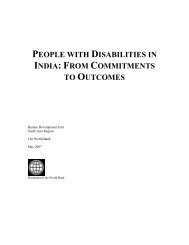FREE Download - TARSHI
FREE Download - TARSHI
FREE Download - TARSHI
Create successful ePaper yourself
Turn your PDF publications into a flip-book with our unique Google optimized e-Paper software.
enefits that might accrue to the community because of the research findings. There were no false<br />
promises or material incentives offered to the community or participants. Some researchers shared their<br />
findings with the community in the spirit of reciprocity. Khanna et al (2000) and Amin et al (1996) used<br />
the research findings to devise strategies to improve the health of the people in the community.<br />
Sodhi (2000) also devised a study to feed back the results into strengthening an ongoing adolescent<br />
health programme in the community. Chandiramani's (1998) research was borne out of an intervention<br />
programme and results were used to improve the services provided.<br />
Most of the researchers discovered that there is a dismal lack of information about sexuality. They also<br />
discovered that their respondents often engaged in highly risky behaviour or were distressed because<br />
of misconceptions that they had. Though they recommend that attempts be made to provide people with<br />
more information, they do not state what they did to remove misconceptions. Admittedly, their role is that<br />
of researchers and not providers of information, but in terms of giving something back to participants,<br />
they do not mention whether they even referred participants on to other sources of accurate information.<br />
An exception to this is Tikoo (1995) who states that provision was made for the research participants to<br />
anonymously seek further information on the telephone about sexuality and AIDS. However, she does<br />
not go on to say whether anyone did this. In this context, it is also important to note that this particular<br />
study involved 10 to 17 year olds responding in writing to a questionnaire that included technical terms<br />
for sexual acts. It is possible that the questionnaire served as a sexuality education tool for some of the<br />
respondents and that it served to confuse some others. Sachdev (1999) ensured anonymity of<br />
responses to the questionnaire administered. Before administering the questionnaire, he also spent time<br />
with the students to create an atmosphere of comfort. However, he does not state whether any<br />
corrective information was provided to the students later. On the other hand, when Sharma and Sharma<br />
(1997) found that their research participants lacked information about sexuality, they motivated school<br />
teachers to conduct sexuality education sessions.<br />
VI. CONCLUSION<br />
Research Gaps<br />
This review of studies on sexuality and sexual behaviour research conducted in India in the last ten<br />
years serves to confirm that in India, people have sex, begin sexual activity in their middle to late teens,<br />
are resistant to using condoms, engage in activities that place them at risk of infection and unwanted<br />
pregnancy, have notions of sexual illness and health that are not necessarily congruent with bio-medical<br />
models; and, that sexual coercion and violence occur. What is missing is a layered exploration of these<br />
issues and a nuanced understanding of the circumstances and dynamics in which these findings hold<br />
true. More importantly, what needs to be factored in to any research that claims to study sexuality,<br />
is that sexuality is not a uni-dimensional construct restricted to behaviour and actions, nor is it governed<br />
by linear principles of causality.<br />
There are no studies on the perceptions, vulnerabilities and sexual practices of older people, single<br />
women, people with disabilities, people who are lesbian, gay or bisexual, and people living with<br />
HIV/AIDS, to name just a few. The so-called 'general population' is conspicuous by its absence. Studies<br />
that uncovered that men have sex with men and sometimes also with animals did not pursue these lines<br />
of exploration. There is predominantly a heterosexist bias to the studies. Hardly any of the studies<br />
address gay male, lesbian, bisexual or trans-gender sexuality as a lived reality, much less try to<br />
18










